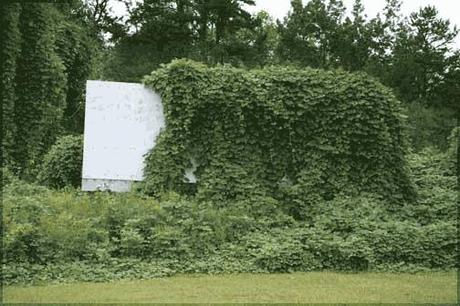(Thank You Alicia..a.k.a. lpyrbby )
I figured this was a problem that is starting to reach many parts of the Southeast, so I might want to get a handle on it. This is one of those situations, are you a good bug or a bad bug? Think Wizard of Oz here.
It's scientific name is Megacopta cribraria. It is better known as Bean Plataspid, Lablab Bug, Globular Stink Bug, or Kudzu Bug. It is pea-sized and brownish with a wide back end, kind of like a boxy ladybug.

It was first discovered, I use discovered because it had not been found anywhere on this continent, until Halloween weekend 2009 in Northeast Georgia. Gives a whole new meaning to "Trick or Treat" doesn't it? Let me give you the evidence for good versus bad.
I will start here. The Kudzu Bug eats, what else? Kudzu.
Kudzu is itself an invasive plant. Some of its nicknames include, "Mile a Minute Plant" and "The Vine that Ate the South".

Photo courtesy of Insectsinthecity
The Kudzu plant was introduced to the United States in 1876 at the Centennial Exposition in Philadelphia, then was introduced into the Southeastern United States in 1883 at the New Orleans Exposition. The vine was widely marketed as an ornamental plant to be used to shade porches. In the first half of the 20th century, Kudzu was distributed as a high protein cattle fodder. It was also used as a cover plant to help prevent soil erosion. The Soil Erosion Service recommended its use to control the erosion of slopes, which led to the government aided distribution of 85 million seedlings and government funded plantings. Since then it has been spreading in the Southern U.S. at the rate of 150,000 acres annually. Its quick growth wreaks havoc on the ecosystem, it smothers and strangles other plants, uproots trees and breaks branches with its weight. It tops the nation's invasive species list.
Now, along comes the Kudzu Bug. Its favorite delicacy, Kudzu. The good news here is, it may slow down the spread of this rapidly growing vine, though not significantly. Any help is greatly appreciated.
Sounds like all good news huh?
Well, hold on a second. Did I mention this thing is a type of stinkbug? The smell has been described as "not an awful smell, more of a bittersweet, pungent, unpleasant odor". Some people have reported being able to smell the stench from their cars while crews are cutting Kudzu overgrowth along highways.
Okay fine, get a heavy duty air freshener for your car.
Well, there is more. As Fall approaches and the Kudzu begins to lose its leaves, the bug needs somewhere to go. Apparently they have been seen congregating on light colored surfaces, especially the white parts of houses.
They can invade your attic or crawl space, looking for a place to hunker down for the Winter. A basic insecticide for household pests will temporarily control them around your home, but the best defense is to have good screening up on all of your openings. You will want to gently remove these guys from your home, should they get inside. Squishing them will leave a stain and stink up the joint. Use a vacuum to suck them up, then remove the bag immediately to an outside trash can or place the bugs in a container of soapy water.
Have you decided yet? Good Bug or Bad Bug?
It may help alleviate our Kudzu problem here in the Southeast. The bug can now be found in 143 Georgia counties, all South Carolina counties, 42 North Carolina counties and 5 Alabama counties. As long as we have a good air freshener and some bug spray, we can kind of control him and his stench.
HOWEVER, you knew there was one more caveat didn't you?
The folks in the agriculture world are a little nervous. See, this thing has an appetite for more than just Kudzu. Apparently, it has discovered it likes Wisteria, which again may not be a bad thing here in the South, but also Soybeans, Green Beans and it possibly could be heading for a famous legume, Peanuts. There is also concern that its tastes could broaden even wider. There is no known natural enemy to the Kudzu Bug here in the United States.
How the bug got here remains a mystery. So you decide, Good Bug or Bad Bug? Either way, this is one wicked "Trick or Treat" bestowed upon the United States!
Happy Growing!
Darren

